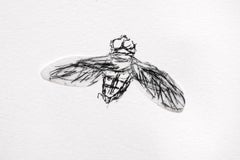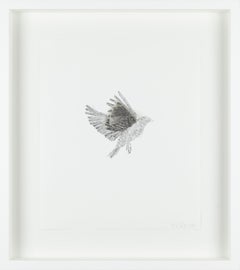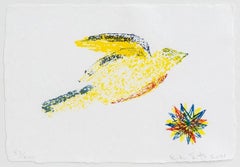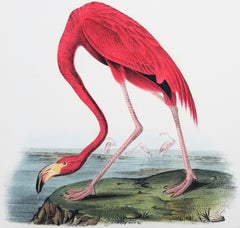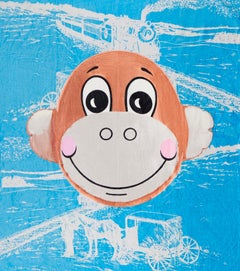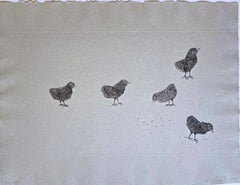Kiki Smith Animal Prints
American, b. 1954
Born in Germany in 1954, the daughter of minimalist sculptor Tony Smith, Kiki Smith was raised in the United States and has earned international status as one of the most significant artists of her time. She was chiefly influenced by Louise Bourgeois, Eva Hesse and Lee Bontecou. While she is best known for her often dissected, anatomical sculptures, she has also produced a body of innovative printed art.
Some of the major themes that Smith explores in her printed works include physiology, self-portraiture, nature, and female iconography. While her work in both mediums share a common psychological quality, she advances beyond the strict biological emphasis in her sculpture by including images such as snowflakes and butterflies in her prints.
Smith’s work has been featured at five Venice Biennales and she has had several major solo museum shows.Smith’s work is in several major museum collections, including the Museum of Modern Art, New York; Whitney Museum of American Art, New York; the Walker Art Center, Minneapolis; Solomon R. Guggenheim Museum, New York; The Metropolitan Museum of Art, New York; and the Museum of Contemporary Art, Los Angeles. She is a member of the American Academy of Arts and Letters and the American Academy of Arts and Sciences. In 2017, she was made an Honorary Royal Academician by the Royal Academy of Arts, London. In 2000 she was awarded the Skowhegan Medal for Sculpture and in 2009 the Edward MacDowell Medal. She also received the 2010 Nelson A. Rockefeller Award, Purchase College School of the Arts; the 2013 U.S. Department of State Medal of Arts, conferred by Hillary Clinton; and the 2016 Lifetime Achievement Award from the International Sculpture Center, to name just a few. Smith is an adjunct professor at NYU and Columbia University and lives and works in New York.to
1
1
1
1
Overall Width
to
Overall Height
to
2
1
24
194
162
118
99
3
1
2
2
2
1
1
2
2
1
1
1
2
1
4
Artist: Kiki Smith
Kiki Smith, Tattoo Print, silkscreen and ink transfer on wove paper, S/N, Framed
By Kiki Smith
Located in New York, NY
Kiki Smith
Tattoo Print, 1995
Silkscreen and ink transfer on wove paper
Signed, dated 1995 and numbered 96/100 in graphite pencil on the front
Another example of this edition is in t...
Category
1990s Contemporary Kiki Smith Animal Prints
Materials
Ink, Screen
Kiki Smith Lithograph/Collage Various Flying Creatures "bee" Signed Dated
By Kiki Smith
Located in Detroit, MI
A collage lithograph from her series Various Flying Creatures by Kiki Smith titled: "bee." Smith has used one of her animal/insect iconic figures for this glassine paper and wove pap...
Category
1990s American Modern Kiki Smith Animal Prints
Materials
Paper, Lithograph
Flying Creatures: Bird
By Kiki Smith
Located in Columbia, MO
Kiki Smith (American, born 1954) is a German-born American artist recognized for her figural works exploring mortality, sexuality, and the human body. Influenced by Surrealism and he...
Category
Late 20th Century Contemporary Kiki Smith Animal Prints
Materials
Mixed Media, Lithograph, Vellum
Red Breast
By Kiki Smith
Located in New York, NY
Once again returning to the themes of death and rebirth, in 2021 Kiki Smith introduced Red Breast as a unique print created with rubber stamps and watercolor. Hand-signed, dated and ...
Category
21st Century and Contemporary Kiki Smith Animal Prints
Materials
Watercolor
Related Items
American Flamingo /// John James Audubon Natural History Ornithology Bird Litho
By John James Audubon
Located in Saint Augustine, FL
Artist: John James Audubon (American, 1785-1851)
Title: "American Flamingo" (Plate 375, No. 75)
Portfolio: The Birds of America, First Royal Octavo E...
Category
1840s Victorian Kiki Smith Animal Prints
Materials
Watercolor, Lithograph
Jeff Koons Monkey Train beach towel (Jeff Koons Monkey Train blue)
By Jeff Koons
Located in NEW YORK, NY
Jeff Koons Monkey Train beach towel 2008:
A highly decorative limited edition 2008 Jeff Koons Monkey Train towel. Measuring 70x60 inches - this work would look outstanding framed.
This outstanding Jeff Koons Monkey Train collectible...
Category
Early 2000s Pop Art Kiki Smith Animal Prints
Materials
Cotton, Digital, Lithograph, Screen
Whooping Crane /// John James Audubon Ornithology Natural History Wading Birds
By John James Audubon
Located in Saint Augustine, FL
Artist: John James Audubon (American, 1785-1851)
Title: "Whooping Crane" (Plate 313, No. 63)
Portfolio: The Birds of America, First Royal Octavo Edition
Year: 1840-1844
Medium: Origi...
Category
1840s Victorian Kiki Smith Animal Prints
Materials
Watercolor, Lithograph
Snowy Heron /// John James Audubon Natural History Ornithology Snowy Egret Bird
By John James Audubon
Located in Saint Augustine, FL
Artist: John James Audubon (American, 1785-1851)
Title: "Snowy Heron" (Plate 374, No. 75)
Portfolio: The Birds of America, First Royal Octavo Edition
Year: 1840-1844
Medium: Original...
Category
1840s Victorian Kiki Smith Animal Prints
Materials
Watercolor, Lithograph
Brown Pelican /// John James Audubon New Orleans Ornithology Animal Bird Art
By John James Audubon
Located in Saint Augustine, FL
Artist: John James Audubon (American, 1785-1851)
Title: "Brown Pelican" (Plate 424, No. 85)
Portfolio: The Birds of America, First Royal Octavo Edition
Year: 1840-1844
Medium: Origin...
Category
1840s Victorian Kiki Smith Animal Prints
Materials
Watercolor, Lithograph
George Edwards: 18th Century Engravings of Ducks And Wading Birds
By George Edwards
Located in Richmond, GB
George Edwards: ""A History of Uncommon Birds"", 1749-1761.
A prominent English naturalist and ornithologist, George Edwards (1694 -1773) is best known for his work, ""A Natural Hi...
Category
18th Century Kiki Smith Animal Prints
Materials
Watercolor, Engraving
$1,650
H 15.75 in W 13.75 in D 1 in
Mary Chenoweth Abstract Birds in Flight Vintage Mid-Century Modern Lithograph
Located in Denver, CO
This vintage original lithograph by celebrated American modernist Mary Chenoweth (1918–1999) presents a dynamic abstract interpretation of birds in flight. Chenoweth’s innovative pri...
Category
1970s American Modern Kiki Smith Animal Prints
Materials
Lithograph
$2,450
H 34.25 in W 27.25 in D 1.5 in
No One is Happier than Me
By David Shrigley
Located in London, GB
11 Colour Screenprint on Somerset Tub Sized 410gsm Paper
hand-signed and numbered
76 x 56 cm
Edition 77 of 125
published by Jealous Gallery and comes with publisher COA
David Shri...
Category
2010s Contemporary Kiki Smith Animal Prints
Materials
Screen
"White Calf, " Farm Genre Scene Original Lithograph by Thomas Hart Benton
By Thomas Hart Benton
Located in Milwaukee, WI
"White Calf" is an original lithograph print by Thomas Hart benton. It features the image of a man milking a cow while her calf lays down in front. Benton's breathtaking way of rende...
Category
1940s American Modern Kiki Smith Animal Prints
Materials
Lithograph
$2,972 Sale Price
20% Off
H 18.13 in W 20.88 in
Nebraska Evening
By Thomas Hart Benton
Located in London, GB
A fine impression with good margins published by Associated American Artists.
Category
1940s American Modern Kiki Smith Animal Prints
Materials
Lithograph
Haystack
By Thomas Hart Benton
Located in London, GB
A fine impression of this very popular image with full margins (smaller on top and bottom) published by Associated American Artists.
Category
1930s American Modern Kiki Smith Animal Prints
Materials
Lithograph
Walled Off Hotel Boxed Set Assemblage w/original embossed receipt from Bethlehem
By Banksy
Located in New York, NY
Banksy (after)
Walled Off Hotel Boxed Set Assemblage, 2018
Mixed Media assemblage: unique piece of concrete/cement wall with framed lithograph.
Accompanied by original embossed rece...
Category
2010s Street Art Kiki Smith Animal Prints
Materials
Concrete
$2,400 Sale Price
20% Off
H 10 in W 10 in D 1.75 in
Previously Available Items
Birdies
By Kiki Smith
Located in New York, NY
Kiki Smith
Little Chicks, 1998
One color etching on Ruscombe Mill Girtin 180 gsm paper with deckled edges
22 × 28 3/4 inches
Edition 74/100
Signed, dated and numbered in graphite low...
Category
1990s Contemporary Kiki Smith Animal Prints
Materials
Etching
Untitled (Bird)
By Kiki Smith
Located in New York, NY
This lithograph and collage on Wove paper was created in 1998. Signed by the artist in pencil and dated in a paper folder with the printed title, from an ...
Category
1990s Contemporary Kiki Smith Animal Prints
Materials
Lithograph, Mixed Media
Kiki Smith animal prints for sale on 1stDibs.
Find a wide variety of authentic Kiki Smith animal prints available for sale on 1stDibs. You can also browse by medium to find art by Kiki Smith in lithograph, paper and more. Much of the original work by this artist or collective was created during the 1990s and is mostly associated with the modern style. Not every interior allows for large Kiki Smith animal prints, so small editions measuring 17 inches across are available. Customers who are interested in this artist might also find the work of Ray H. French, Carol Wax, and Beniamino Bufano. Kiki Smith animal prints prices can differ depending upon medium, time period and other attributes. On 1stDibs, the price for these items starts at $1,500 and tops out at $1,500, while the average work can sell for $1,500.
Artists Similar to Kiki Smith
Questions About Kiki Smith Animal Prints
- 1stDibs ExpertApril 5, 2022Kiki Smith is a contemporary artist whose career has included sculpture, drawing, painting and other media to address issues such as mortality, gender and nature. Her multidisciplinary work is sought after by collectors worldwide. On 1stDibs, shop expertly-vetted Kiki Smith pieces from some of the world’s top art dealers.

